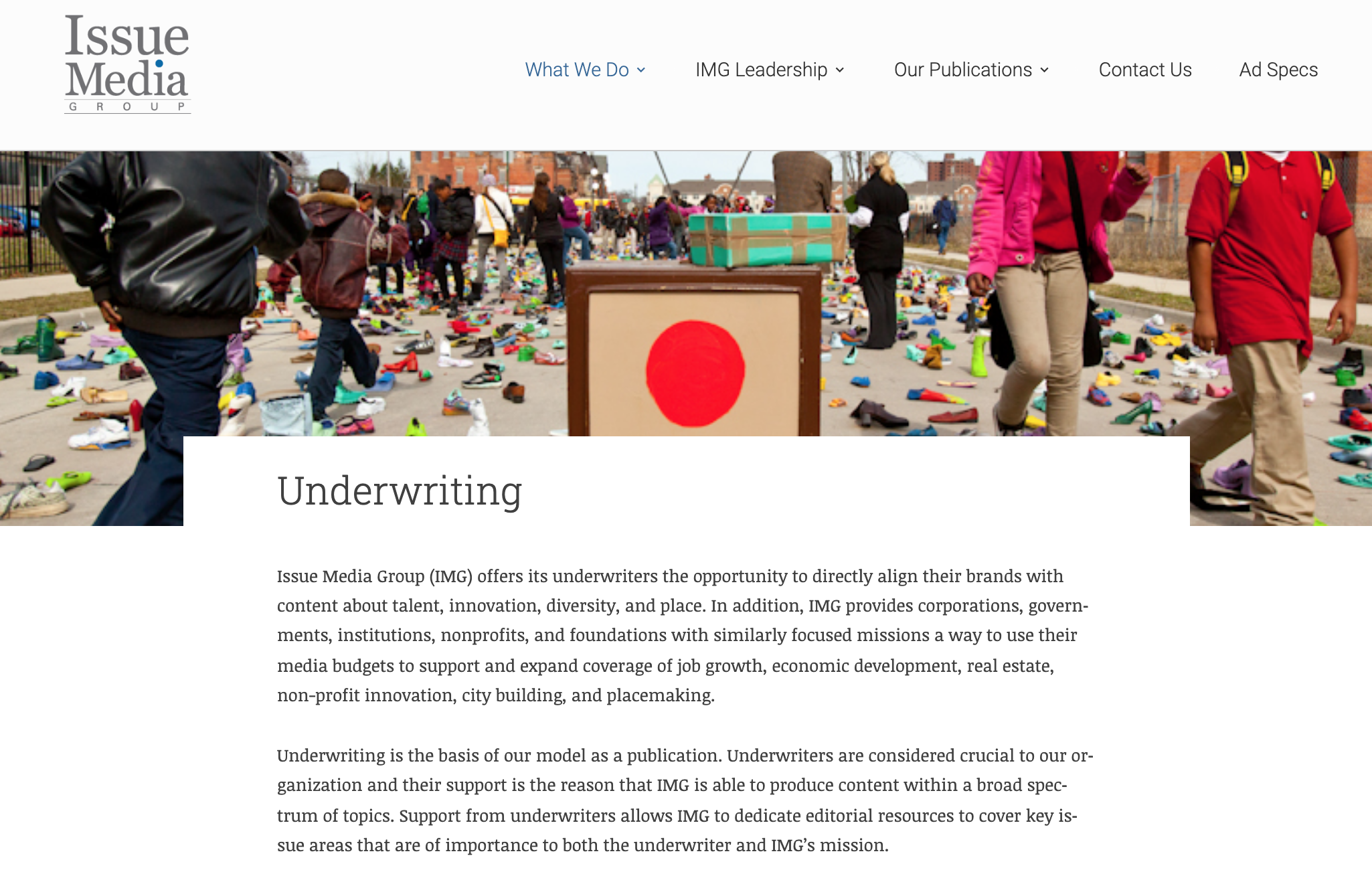Issue Media Group
Using foundations to receive underwriting for solutions-oriented media brands
The Issue Media Group, a for-profit organization with 20 publications across parts of the country, has developed a business model around underwriting, a concept akin to sponsorship that generates support for the production of content.
IMG describes its mission as leveraging “the power of solutions-based + narrative storytelling in partnership with community-based leadership coalitions to increase attachment to place – a foundational element to inclusive economic growth – while delivering community response to local media contraction.”
Paul Schutt, IMG’s co-founder and co-executive director, said leveraging the power of solutions-based and narrative journalism is core to IMG’s approach.
IMG introduces the concept of solutions journalism in a slide deck used for presentations with funders. After outlining reasons for focusing on this type of coverage, Schutt explains that a typical article would “frame the problem in the first half of a piece, then look at at least two initiatives trying to address it.” This opportunity to explain what solutions journalism entails frequently leads to an “aha” moment for potential clients.
This group shows that building a localized media brand, such as Soapbox Cincinnati, around solutions-oriented content — in contrast to making it a focus among an array of other approaches — is a sound business strategy. Since its founding, the company has attracted financial support to create content that explicitly centers on what is working in the communities it covers.
95% of IMG’s revenue is connected to solutions journalism through underwriting agreements made on an annualized basis with a coalition of partners. While most of the money is connected to straight reporting, some contracts include a clause offering partners a deal on sponsored content.
The majority of their funding stems from underwriting provided by or channeled through local foundations and institutions. Underwriters are recognized with their logos under a “sponsored by” label at the bottom of every page. Across the group’s portfolio, 60 funders are foundations.
Only a small proportion of the group’s revenue comes from corporate sponsorships or advertisers.
When setting up a new property, Schutt says the company aims to secure a funding commitment of three to five years, ideally from a network of funders. In its experience of previous launches, too little runway capital could create financial uncertainty and jeopardize the longer-term sustainability of a publication.
In some instances, IMG opts to create a fund with a community foundation to support its work, such as with the Community Foundation of Greater Memphis, or through the Community Foundation of Tampa Bay’s Solutions Journalism Fund. In places where establishing a fund through a fiscal sponsor is less advantageous, IMG complies with restrictions on funding for-profit organizations by receiving grants under the terms of Expenditure Responsibility, which allows for accepting money that would otherwise go only to nonprofits so long as it is used for charitable purposes.

KEY TIPS:
Impact-fueled success
While solutions-oriented coverage provides a key selling point to potential financial backers, IMG puts an emphasis on robust impact tracking and reporting to nurture relationships after the initial deal.
IMG has developed a bespoke impact-gathering process. On publication, its CMS sends an email to story sources asking that they inform the publication about the influence of its articles and notifies them that a survey will be sent after 90 days.
If the survey finds any examples of impact, a team within IMG returns to the source to flesh out the information. It is then shared in an impact report with the funder that provided underwriting and would have an interest in that story. Examples of impact following coverage that they have corroborated with sources and highlighted to financial backers include, organizations receiving funding and donations, or increased media coverage and participation of volunteers.
IMG showcases the influence of their publications’ reporting on individuals or organizations in their annual reports to underwriting clients. Tracking impact is an essential practice to help them attract underwriting support from coalitions of funders to support their journalism and sustain financial viability.
Developing community foundation funds
A donor-advised fund within a community foundation helps to funnel funds from other foundations and individuals. It can also provide newsrooms with a fiscal sponsor structure. When considering the creation of one, Schutt recommended making direct contact with the CEO; a program officer alone is unlikely to have the authority to set the process in motion. This is in part because they won’t have funded media before and due to the potential novelty of the Expenditure Responsibility grant. The board of trustees will need to be consulted, usually by the CEO, before a new fund is set up.
One important strategy for attracting foundation funds is to seek match funding. To incentivize raising money at once from several sources, Schutt said a good place to start is by asking for $12,000 from a coalition of 10 community institutions to support the launch of a publication in a new market. Getting a three-year commitment of funding is the ideal scenario to ensure a publication’s viability.
Here is an agreement for a donor-advised fund.
IMPACT-FUELED SUCCESS

While solutions-oriented coverage provides a key selling point to potential financial backers, IMG puts an emphasis on robust impact tracking and reporting to nurture relationships after the initial deal.